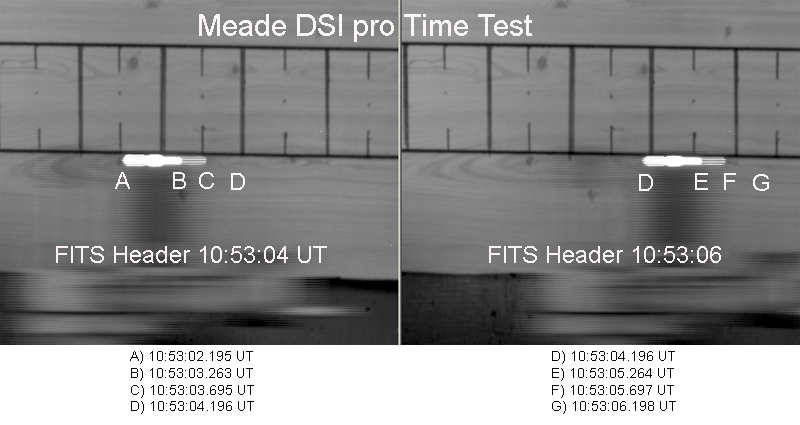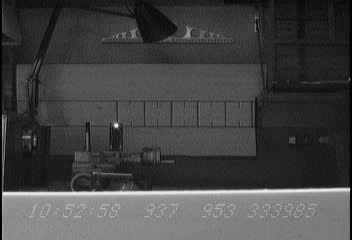Shutter tests for the Meade DSI Pro
Dave Gault
July 18, 2006
Goal
To understand the time line cycle of the Meade Deep Sky Imager
pro (DSIpro) Camera when used to collect images for time sensitive
applications, i.e. the Pluto Occultation.
Equipment
- DSIpro fitted with a Pentax 28mm lens controlled by DELL laptop PC.
- KIWI OSD system consisting of PC164c video camera (NTSC),
6" monitor, KIWI OSD, GPS system to supply time standard,
Canon Camcorder.
- Subject, a 12volt 1.3AH battery fitted with a Red LED,
mounted on the bed of my lathe and the feed
set as fast as it could go.
Method Summary
Setup the DSIpro camera and make 1 second exposures of a moving subject
while at the same time video the activity with a time inserter equipment
(KIWI OSD) and then correlate the two processes.
Method Details
- the laptop's clock was synced by use of the internet feature
of "date and time" control panel.
- the KIWI OSD system was setup and a GPS fix was obtained.
- the video camera was pointed at the laptop screen that was showing
the date and time control panel and it was found
that the laptop was 0.320
seconds slow to UTC
- the DSIpro was setup to record 1 second exposures, saving all RAW
frames, in FITS format, with combine images unchecked.
- Both the DSIpro and the video camera were pointed at the subject and
the Battery/LED assembly was fed along the bed of my lathe.
- Inspect the frames. The first frame is effected by acceleration of
the lathe and has been omitted. The last frame is incomplete and has
been omitted as well. The middle two frames provide a good continuity;
they appear in the picture below.
- look through the videotape to find the corresponding section and note
the KIWI OSD display.

Analysis
- The first scan shows 10:53:04UT in the FITS header. The next scan is
10:53:06 UT
- Inspection of the LED streak reveals that the accumulation of photons
is not consistent over the duration of the exposure cycle.
- The first frame of an MPEG movie showing the
video record with the KIWI OSD is shown below.

From a close inspection of this movie, the interesting
points of the exposure of the DSIpro can be estimated.
- Analysis of the first scan and the movie reveal...
- the 10:53:04 UT scan starts at 10:53:02.195UT and the LED leaves a
wide trail to the right
- the width of the streak varied in width and at 10:53:03.263UT the
solid streak ends and changes to show only half of an interlaced field.
- at 10:53:03.695 UT the exposure ends.
- during the next 0.501 seconds the file is transferred and processed
within the PC and in the last 0.196 seconds the header is created and
the file written to disk.
- at 10:54:04.196 the next exposure commences.
Conclusions.
- The time given in the FITS Header is for the END of the
exposure/download cycle
- The exposure time is 1.5 seconds.
- There is a dead time or image download time of 0.5 seconds.


